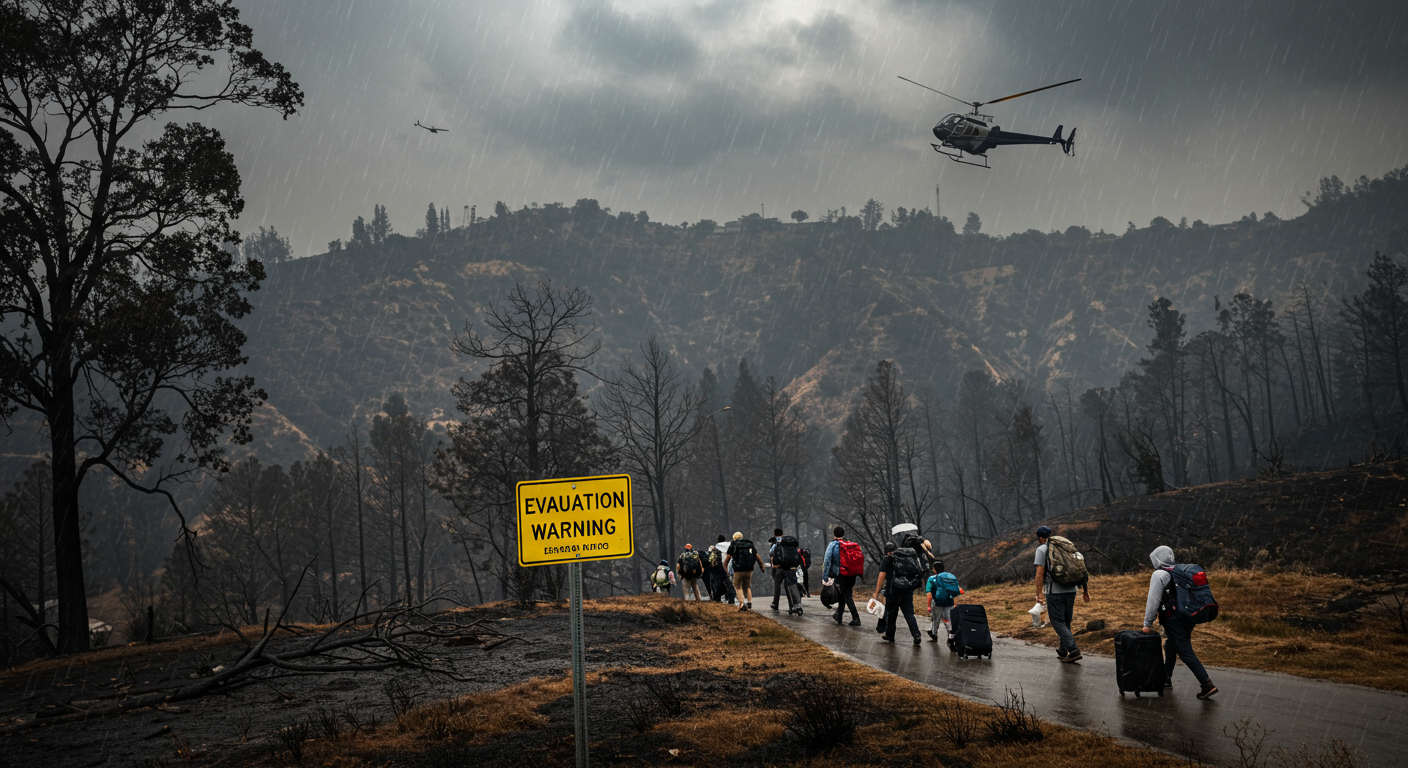Evacuation Warnings Issued for Los Angeles Wildfire Burn Areas Amid Heavy Rainfall
Los Angeles, CA – Authorities have issued evacuation warnings for multiple wildfire burn areas across Los Angeles County as heavy rainstorms are set to bring dangerous conditions, including mudslides, debris flows, and flooding. The National Weather Service (NWS) has placed parts of Southern California under flood watches, with rainfall rates potentially reaching one inch per hour in the most affected areas.
Officials urge residents in vulnerable zones to stay alert and prepare to evacuate if conditions worsen. These warnings come as recent wildfires, including the Palisades Fire, Eaton Fire, and Hughes Fire, have left the landscape highly unstable. The combination of burnt vegetation and intense rain increases the likelihood of landslides and flash flooding.
Storm Forecast and Timeline
The latest weather models predict a series of Pacific storms starting March 12, 2025, bringing heavy rain to Los Angeles and surrounding counties. The first wave is expected to hit early in the morning, with moderate showers turning into steady, heavy rain by the afternoon. Winds could also reach 25 to 35 mph, adding to the concerns for downed trees and power outages.
On March 13, 2025, a second system will move through, bringing isolated thunderstorms and increasing the risk of flash floods in wildfire burn areas. By the evening, the heaviest rainfall should taper off, but lingering showers and wet conditions will persist.
By March 14, 2025, forecasters expect a gradual clearing, though scattered showers could continue in some areas. Officials warn that even after the rain stops, the risk of landslides and unstable ground conditions remains high.
Evacuation Warnings and Affected Areas
Los Angeles County’s emergency services have identified several at-risk zones where residents should be prepared to leave at a moment’s notice:

- Palisades Fire Burn Area – This includes Getty Villa, Temescal Canyon, and Rivas Canyon, where slopes remain highly unstable.
- Sunset Fire Burn Area – Areas east and south of Runyon Canyon have been flagged as potential mudslide zones.
- Hughes Fire Burn Area – The Oakridge Mobile Home Park near Olive Lane faces significant flooding risks.
The Los Angeles Fire Department (LAFD) has deployed emergency response teams to monitor conditions and assist residents. Those in high-risk areas are urged to pack an emergency go-bag, including important documents, medications, and essential supplies.
Threat of Mudslides and Flooding
The biggest concern in these wildfire-affected regions is the lack of vegetation to absorb water. With burned soil unable to hold moisture, heavy rainfall could trigger fast-moving debris flows, carrying mud, rocks, and even fallen trees into neighborhoods.
“The problem isn’t just the rain—it’s the way the water interacts with these burn areas,” said NWS Meteorologist Emily Carter. “Even moderate rainfall can send mud and debris rushing down canyons and roadways, blocking escape routes and damaging homes.”
In addition to landslides, urban flooding is a major threat, particularly in low-lying areas of Los Angeles where storm drains may become overwhelmed. Emergency officials advise residents to avoid driving through flooded roads, as water depth can be deceiving and lead to life-threatening situations.
Emergency Preparedness and Safety Measures
Authorities strongly recommend residents take precautionary steps ahead of the storm:
- Stay Informed – Follow official alerts from LAFD, the NWS, and local news stations for real-time updates.
- Prepare to Evacuate – If you live in an affected area, pack essentials and have a plan to leave quickly if orders are upgraded to mandatory evacuations.
- Secure Your Property – Use sandbags to prevent flooding, clear gutters and drains, and move valuables to higher ground.
- Avoid Flooded Roads – Do not drive or walk through flooded areas, as water depth and speed can be deceptive.
Residents are encouraged to sign up for emergency alerts via Ready LA County and check the LAFD website for ongoing updates.
What Comes Next?
While Los Angeles frequently experiences winter and early spring storms, the interaction of heavy rainfall with recent wildfire burn areas makes this event particularly dangerous. Experts predict that as climate patterns shift, these extreme fire-flood cycles will become more common, requiring better long-term planning and mitigation efforts.
For now, residents are urged to take evacuation warnings seriously and prepare for worsening conditions. Emergency crews remain on high alert, ready to assist those in need. If you are in a burn area, be proactive—do not wait until it’s too late to evacuate.
For the latest updates, visit: LAFD.org and weather.gov.





